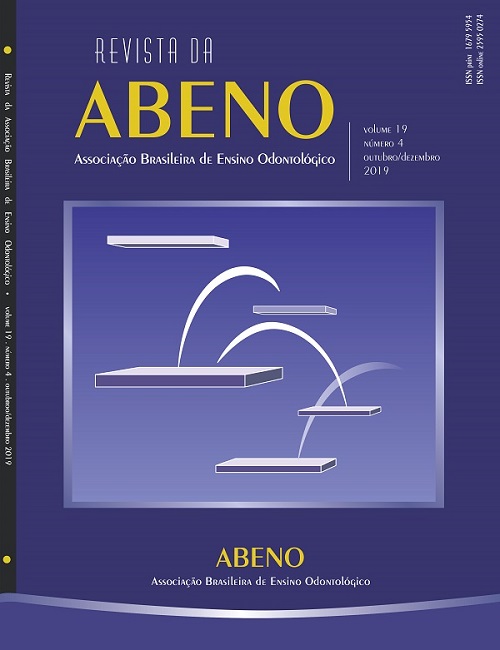The teaching of minimally invasive dentistry: an experience report
DOI:
https://doi.org/10.30979/rev.abeno.v19i4.745Keywords:
Education, Dental. Decision Making. Clinical Case. Dental Caries.Abstract
For many years, teaching dentistry has been based solely on the reproduction of restorative techniques, students being motivated merely to perform procedures without developing reflective skills, which are as important as the techniques themselves. This experience report discusses a clinical case and problematizes the teaching of minimally invasive dentistry. Discussions were held and the formulation of tables and charts was performed by the students, as well as the compilation of a practical guide to help with the choice of restorative treatment. The activities were considered productive and complementary in solving lingering doubts. It was concluded that the use of the active methodology reported in knowledge building was an important strategy for the creation of learning situations in the approach to minimally invasive dentistry. Meaningful learning from an ongoing clinical case proved to be an important teaching strategy.
Downloads
References
Marcenes W, Kassebaum NJ, Bernabe E, Flaxman A, Naghavi M, Lopez A, et al. Global burden of oral conditions in 1990-2010: a systematic analysis. J Dent Res. 2013;92(7):592-7.
Robertson MD, Schwendicke F, de Araujo MP, Radford JR, Harris JC, McGregor S, et al. Dental caries experience, care index and restorative index in children with learning disabilities and children without learning disabilities; a systematic review and meta-analysis. BMC Oral Health. 2019;19(1):146.
Jordan RA, Krois J, Schiffner U, Micheelis W, Schwendicke F. Trends in caries experience in the permanent dentition in Germany 1997-2014, and projection to 2030: Morbidity shifts in an aging society. Sci Rep. 2019;9(1):5534.
Kidd EA, Fejerskov O. What constitutes dental caries? Histopathology of carious enamel and dentin related to the action of cariogenic biofilms. J Dent Res. 2004;83 Spec No C:C35-8.
Schwendicke F. Less Is More? The Long-Term Health and Cost Consequences Resulting from Minimal Invasive Caries Management. Dent Clin North Am. 2019;63(4):737-49.
Schwendicke F, Splieth C, Breschi L, Banerjee A, Fontana M, Paris S, et al. When to intervene in the caries process? An expert Delphi consensus statement. Clin Oral Investig. 2019.
Chisini LA, Conde MC, Correa MB, Dantas RV, Silva AF, Pappen FG, et al. Vital Pulp Therapies in Clinical Practice: Findings from a Survey with Dentist in Southern Brazil. Braz Dent J. 2015;26(6):566-71.
Gomez J, Ellwood RP, Martignon S, Pretty IA. Dentists' perspectives on caries-related treatment decisions. Community Dent Health. 2014;31(2):91-8.
Kakudate N, Sumida F, Matsumoto Y, Yokoyama Y, Gilbert GH, Gordan VV. Patient age and dentists' decisions about occlusal caries treatment thresholds. Oper Dent. 2014;39(5):473-80.
Domejean S, Leger S, Maltrait M, Espelid I, Tveit AB, Tubert-Jeannin S. Changes in Occlusal Caries Lesion Management in France from 2002 to 2012: A Persistent Gap between Evidence and Clinical Practice. Caries Res. 2015;49(4):408-16.
Innes NPT, Schwendicke F. Restorative Thresholds for Carious Lesions: Systematic Review and Meta-analysis. J Dent Res. 2017;96(5):501-8.
Chisini LA, Noronha TG, Ramos EC, Dos Santos-Junior RB, Sampaio KH, Faria ESAL, et al. Does the skin color of patients influence the treatment decision-making of dentists? A randomized questionnaire-based study. Clin Oral Investig. 2018.
Chisini LA, Collares K, Bastos JLD, Peres KG, Peres MA, Horta BL, et al. Skin color affect the replacement of amalgam for composite in posterior restorations: a birth-cohort study. Braz Oral Res. 2019;33:e54.
Secco LG, Perreira MLT. The teaching of dentistry: professionalization of university teaching and the challenges of the political-structural dimension Ciênc Saúde Coletiva. 2004;9(1):113-20.
Innes NPT, Chu CH, Fontana M, Lo ECM, Thomson WM, Uribe S, et al. A Century of Change towards Prevention and Minimal Intervention in Cariology. J Dent Res. 2019;98(6):611-7.
Aquilante AG, Tomita NE. O estudante de Odontologia e a educação. Revista da ABENO. 2005;5(1):6-11.
Chisini LA, Collares K, Cademartori MG, de Oliveira LJC, Conde MCM, Demarco FF, et al. Restorations in primary teeth: a systematic review on survival and reasons for failures. Int J Paediatr Dent. 2018;28(2):123-39.
Bader JD, Shugars DA, Bonito AJ. Systematic reviews of selected dental caries diagnostic and management methods. J Dent Educ. 2001;65(10):960-8.
Cury JA, Tenuta LM. Enamel remineralization: controlling the caries disease or treating early caries lesions? Braz Oral Res. 2009;23 Suppl 1:23-30.
Braga MM, Lenzi TL, Tibério BP, Ferreira FR, Mendes FM, Ekstrand KR. Nova proposta para ensino/treinamento na detecção de lesões de cárie: insights da implementação do método entre estudantes de graduação. Rev ABENO. 2018;18(2):2-12.
Monnerat AF, Cadette C, Monnerat ABL, Barquete CG. Simulação de textura de lesão cariosa para treinamento pré-clínico. Rev ABENO. 2017;17(1):55-61.
Gonzalez-Cabezas C. The chemistry of caries: remineralization and demineralization events with direct clinical relevance. Dent Clin North Am. 2010;54(3):469-78.
Cury JA, de Oliveira BH, dos Santos AP, Tenuta LM. Are fluoride releasing dental materials clinically effective on caries control? Dent Mater. 2016;32(3):323-33.
Lazzarin HC, Nakama L, Júnior LC. Perceptions of dentistry teachers in the teaching and learning process. Ciênc Saúde Coletiva. 2010;15(1801-1810).
San Martin AS, Chisini LA, Martelli S, Sartori LRM, Ramos EC, Demarco FF. Distribution of Dental Schools and dentists in Brazil: an overview of the labor market. Rev ABENO. 2018;18(1):63-73.
Downloads
Published
How to Cite
Issue
Section
License
Autores que publicam nesta revista concordam com os seguintes termos:
a) Autores mantém os direitos autorais e concedem à revista o direito de primeira publicação, com o trabalho simultaneamente licenciado sob a Licença Creative Commons Attribution que permite o compartilhamento do trabalho com reconhecimento da autoria e publicação inicial nesta revista.
b) Autores têm autorização para assumir contratos adicionais separadamente, para distribuição não-exclusiva da versão do trabalho publicada nesta revista (ex.: publicar em repositório institucional ou como capítulo de livro), com reconhecimento de autoria e publicação inicial nesta revista.
c) Autores têm permissão e são estimulados a publicar e distribuir seu trabalho online (ex.: em repositórios institucionais ou na sua página pessoal) a qualquer ponto antes ou durante o processo editorial, já que isso pode gerar alterações produtivas, bem como aumentar o impacto e a citação do trabalho publicado (Veja O Efeito do Acesso Livre).






